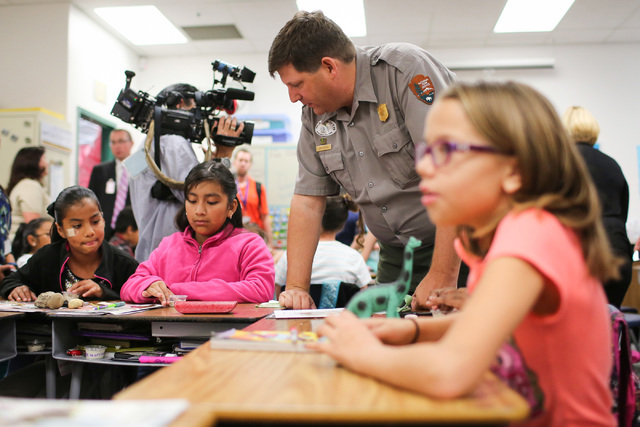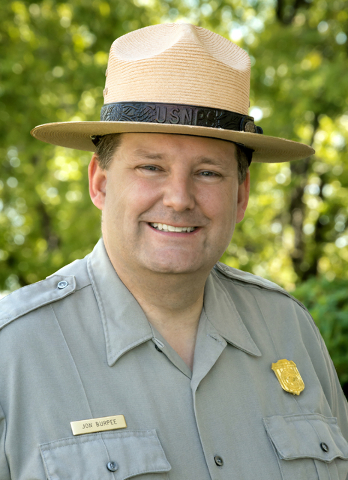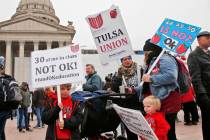Tule Springs monument superintendent looks to grow park outside North Las Vegas
Jon Burpee likes to say he has a mammoth of an undertaking.
As the first permanent superintendent of the Tule Springs Fossil Beds National Monument in Las Vegas, he is in charge of leading the establishment of one of the nation’s newest parks.
The monument was established in December to conserve a collection of fossils that are up to 200,000 years old.
The 22,650-acre monument is just north of Las Vegas and stretches along U.S. Highway 95 north of Aliante and Centennial Hills to Creech Air Force Base.
Burpee has worked for the National Park Service since 1996, when he started as a volunteer at Fort Vancouver National Historic Site in Washington state. He was later hired at Fort Vancouver as a seasonal park ranger. Over his career, he has worked at Death Valley National Park, Fort Frederica National Monument in Georgia and Castillo de San Marcos National Monument in Florida.
He holds a bachelor’s degree in history from the University of Washington and has completed work toward his master’s degree in resources interpretation at Stephen F. Austin State University.
View recently sat down with Burpee for a question-and-answer session.
Tell me about your background. What led you to become the superintendent of Tule Springs Fossil Beds National Monument?
When I was 8 years old, I remember visiting Fort Vancouver National Historic Site. I so vividly remember the park ranger giving us a tour, and he just brought history to life. I wasn’t bright enough to know that’s what I want to do when I grew up, so I went to college for history, and I didn’t know what to do with it. I revisited Fort Vancouver National Historic Site, and the park ranger kind of inspired me. I signed as a volunteer for the park, and they ruined a perfectly good volunteer by hiring me. Twenty years later, here I am.
Where has your career taken you?
I went to Death Valley National Park and fell in love with the desert. It’s so different from the overcast, drizzly Pacific Northwest, which I love as well. I also met my wife in Death Valley, where we were both working as seasonal park rangers.
I returned to Fort Vancouver for a next-level park ranger position.
I then traveled across the country and took a park ranger job at Fort Frederica National Monument in Georgia. One of the things I love about the park system and our country is that there are so many different things to experience. I loved everything about it except for the humidity and biting insects.
In 2012 we went to St. Augustine in Florida to Castillo de San Marcos in Fort Matanzas.
We could’ve stayed there long time, but in January 2014 I became a National Park Service Bevinetto Congressional Fellow and was in Washington, D.C., for 19 months until I came here.
When did you first learn about the Tule Springs Fossil Beds National Monument?
As a Congressional Fellow, one of the bills I got to work on, or at least the National Defense Authorization portion of it, dealt with public lands, and one of the parks it created was the Tule Springs Fossil Beds National Monument. It intrigued me from the start.
For those who are unaware of the monument, can you describe it?
Tule Springs contains an amazing array of Ice-Aged fossils, ranging from the large mammoths that could stand 16 feet tall down to some of the tiniest things fossilized, like seeds and pollen. This is the key to understanding our past and present. What’s great about Tule Springs is it shows us 200,000 years of climate change and what happens when climates change rapidly. Our story is in the soil.
It’s 22,650 acres and 25 miles long. Within those acres, we’ve recovered about 10,000 specimens and have identified 600 fossils at the site by just what’s poking out of the ground.
Our university has a growing geology and paleontology program, and now it has its own outdoor laboratory. It’s very exciting for our students.
What have been some of your greatest challenges as superintendent of the park?
The Protectors of Tule Springs and our community have done an amazing job of raising awareness, but it will still take years to get many people to truly understand what’s out there.
We still have issues where we see people driving off-road, but on the bright side, the area is no longer open to target shooting. For the most part, no one seems to be dumping anymore.
Back when we had our cleanup, our community helped us pick up 44,000 pounds of trash. There was so much out there, but with the fencing and signs, people don’t use this site as a dump anymore.
When I first got here, I spent a lot of time hiking on the weekends. I was amazed at the sheer number of people accessing the park already. Our job is to preserve fossils forever, so right now we’re not really pointing out the fossils to folks. So many of the fossils are the same color as our soil.
A lot of people have sent me GPS coordinates of where they’ve found some bones. It’s great because they leave it there, but a couple of folks have brought me things and we don’t want that. The second the fossils are not at the site, we don’t know where they came from.
That’s also the big challenge with these pre-mineralized fossils. Most people think of fossils being like rocks, but these are bones. People innocently try to pick them up and break them. To recover them there’s a long process that scientists do. We need to get the word out to let people know that they must leave them in place.
You have the opportunity to see this park blossom. What type of vision do you have for it?
We have a very public planning process in the works. This park is the community’s national park. There are standards, but the decision will be made largely by the public. They’ll decide what facilities there’ll be and what types of amenities the park will have.
My vision for this is to create a place where people can go to find solitude away from the busy city, a place where they’ll go to discover about our paleontology’s past.
The phrase that I often use is that planning will take us where we need to go.
There’s so much excitement about the park, but the expectation has to be realistic because the planning process is very thorough and very slow. We only have one shot to do this.
What’s next for the park?
We just hired our first two park employees (other than myself). They’ll be working as park ranger interpreters. Once they’re on board, they’ll be developing hiking programs and will provide more information at the Desert National Wildlife Refuge Visitor Center.
By July I think people will be able to visit the visitor center and get more information about the national park. They’ll also be able to get a national park passport stamp.
In June we’ll have our first advisory council meeting. We’re going to start off by looking at the purpose and role that members play. It’ll be open to the public, and we’ll announce more details on our website. It’ll pretty much be the kickoff to the planning stage of this amazing park.
As part of National Fossil Day in October, we plan to hold a partnership with the Protectors of Tule Springs and the Las Vegas National History Museum for an outdoor event and student art contest.
In the fall, we’re also looking to do a lecture series.
Anything else you’d like people to know?
People come to Las Vegas for a more traditional Las Vegas vacation, but now they’ll be able to experience a national park.
The future of the park is very bright because the community is interested. It’ll take community involvement to make this park happen, but people are stepping up to the plate.
North View reporter Sandy Lopez plans to chat with longtime North Las Vegas resident and community activist Lorena Searles for a July 7 Getting to Know Your Community Leaders question-and-answer profile.
To reach North View reporter Sandy Lopez, email slopez@viewnews.com or call 702-383-4686. Find her on Twitter: @JournalismSandy.
Jon Burpee
Age: 43
Occupation: Superintendent of the Tule Springs Fossil Beds National Monument in Las Vegas
Past Job: National Park Service Bevinetto Congressional Fellow
Education: Bachelor's degree in history from the University of Washington and has completed work toward his master's degree in resources interpretation at Stephen F. Austin State University.
Hometown: Longview, Wash.
In Las Vegas since: September 2015
Jon Burpee can be reached at 702-902-0431 or jon_burpee@nps.gov.















